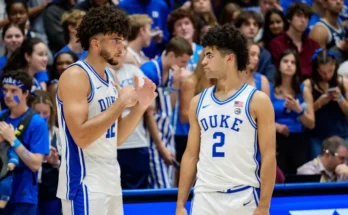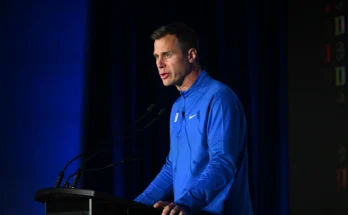Caitlin Clark doesn’t deter Sophie Cunningham: “There have been many trials.”
In a league driven by elite talent and constant evolution, rookies are expected to bring something new to the table—but not everyone is intimidated by the arrival of generational stars. Indiana Fever rookie Caitlin Clark has already captivated the nation with her unprecedented college career and the anticipation surrounding her WNBA debut. Yet, amidst the growing fanfare, veterans like Sophie Cunningham remain grounded in their own journeys, unshaken by the buzz surrounding newcomers. For Cunningham, a battle-tested guard for the Phoenix Mercury, Clark’s arrival is not a threat—it’s just another trial in a career full of them.
“There have been many trials,” Cunningham said recently when asked about Clark’s arrival. “This is just one more.”
That simple statement speaks volumes, revealing a deeper mentality honed through years of adversity, hustle, and resilience in a league where nothing is given and everything is earned.
From Underdog to WNBA Mainstay
To understand why Cunningham isn’t flustered by the Caitlin Clark hype train, it’s important to look back at her own path. A standout at Missouri, Sophie Cunningham entered the league in 2019 as a second-round draft pick—not exactly the red carpet entrance Clark will experience. From the outset, Cunningham had to fight for playing time, recognition, and respect.
Her hard-nosed style of play and emotional fire have earned her a loyal fanbase, but also placed a target on her back. Often polarizing but always competitive, Cunningham brings grit to every game, unafraid to speak her mind or back down from anyone. She’s had to claw her way into relevance in a league that constantly turns over rosters and favors athleticism and flash.
Injuries, roster shifts, and team struggles have been part of her journey. But instead of folding, she’s leaned in—adapting her game, sharpening her shot, and evolving into one of the Mercury’s emotional leaders.
“There’s always someone coming,” Cunningham once said about the competitive nature of the WNBA. “So you either get better, or you get replaced.”
It’s that mindset that perfectly encapsulates her approach to Caitlin Clark.
Clark’s Meteoric Rise
Caitlin Clark enters the WNBA unlike any player in recent memory. After shattering scoring records, drawing unprecedented TV ratings, and almost single-handedly shifting the mainstream focus to women’s college basketball, Clark is poised to be the centerpiece of the Fever’s future.
Her shooting range, court vision, and ability to elevate teammates are already being compared to some of the greatest the league has ever seen. From endorsements with Nike to consistent media attention, Clark’s impact is already massive—and she hasn’t even played a professional game yet.
While many veterans might see this as an intimidating shift, one that puts pressure on existing players to prove their worth or fear being outshined, Cunningham takes the opposite stance.
“She’s good—no doubt,” Cunningham said. “She’s going to be great for the league. But there have been many trials in my career, and each one has made me stronger. Caitlin is just part of the next wave, and I’m still standing.”
A League That Demands Mental Fortitude
Cunningham’s comments reflect the reality for many WNBA players who’ve fought to build careers despite limited roster spots, smaller media coverage, and fewer financial resources than their male counterparts. The average WNBA career spans just a few years. Surviving, let alone thriving, requires more than just talent—it demands resilience.
The league has seen its share of hyped arrivals—Candace Parker, Maya Moore, Breanna Stewart, and A’ja Wilson all entered the WNBA with sky-high expectations. And while they’ve certainly delivered, their success hasn’t come at the expense of veterans who chose to compete, adjust, and stay relevant.
Players like Cunningham understand this better than anyone.
“The league has always evolved,” she said. “That’s how it grows. But people forget that experience still matters. Knowing how to handle tough road games, hard fouls, hostile crowds—that doesn’t go away.”
Competitive Fire: A Shared Trait
Ironically, the thing that makes Caitlin Clark so revered—her fire and competitive edge—is the same quality that defines Cunningham. While Clark celebrates big shots with chest bumps and finger waves, Cunningham dishes out no-look threes and takes charges with a snarl. Both players are emotional. Both are leaders. Both want to win at all costs.
This mutual edge could make for an intriguing dynamic when their teams face off.
“I respect her passion,” Cunningham acknowledged. “I see some of myself in her. That confidence—sometimes it rubs people the wrong way. But if you back it up, you’ve earned it.”
Still, Cunningham makes it clear that respect doesn’t mean deference. When asked whether Clark changes how she prepares or approaches the season, the veteran shrugged.
“I’m preparing the same way I always do. Film, conditioning, chemistry with my teammates—that’s what matters. You don’t win games by worrying about the hype.”
New Era, Same Mentality
The WNBA is on the brink of a significant evolution, and Caitlin Clark is expected to be one of the cornerstones of that change. From increased viewership and merchandise sales to packed arenas and headline-grabbing storylines, the league is becoming a central part of sports culture.
Players like Clark are ushering in that transformation—but it’s veterans like Cunningham who will determine how smoothly the transition happens.
In fact, players who’ve experienced the league’s lean years, when coverage was minimal and salaries were even lower, often feel a mix of excitement and protectiveness about the new attention.
“We’ve fought for this moment,” Cunningham said. “Players like Caitlin get to step into something bigger now—and that’s great. But we’ve been laying that foundation for years. Don’t forget that.”
Trials That Made Her Stronger
Cunningham’s emphasis on “many trials” isn’t just about rookies trying to take her spot. It’s about the injuries that sidelined her, the doubters who questioned her skill set, the contract years with no guarantees, and the relentless need to prove herself season after season.
Her journey has included overcoming back issues, fighting to stay relevant on a Mercury team in transition, and stepping into larger leadership roles when veterans like Diana Taurasi were unavailable.
“It’s a mental game just as much as a physical one,” she explained. “People see what happens on the court. But the real grind happens behind the scenes—getting up when no one’s watching, staying sharp when your minutes go down, keeping belief alive when everything’s telling you to quit.”
So when asked if Caitlin Clark intimidates her, Cunningham doesn’t even blink.
“This league has tried to break me a few times,” she said. “But I’m still here. That should tell you everything.”
Mentorship or Rivalry?
Interestingly, Cunningham’s stance doesn’t necessarily rule out a mentorship role either. She’s spent the past few seasons learning from icons like Taurasi and Skylar Diggins-Smith, and now she sees the opportunity to pass on lessons to the next generation.
“If Caitlin ever wants to talk shop, I’m open,” Cunningham said. “But on game day? It’s go time.”
The duality is clear: competition doesn’t cancel out camaraderie. In fact, it fuels it.
Veterans know that the league is at its best when rookies bring energy and when veterans bring wisdom. The real magic happens when the two forces collide, as they inevitably will when Clark’s Fever meets Cunningham’s Mercury.
The Bigger Picture
The most powerful takeaway from Cunningham’s message might not be what it says about Caitlin Clark, but what it reveals about the WNBA itself. This is a league full of survivors—women who’ve been told no countless times, who’ve played overseas to supplement income, who’ve sacrificed and adapted to keep their dreams alive.
Clark’s arrival signals a new dawn, but the sun still shines on those who’ve weathered the storms.
“There’s room for everyone who wants to work,” Cunningham said. “But no one’s giving up their spot without a fight.”
As the WNBA gears up for what might be its most exciting season ever, one thing is certain: the road won’t be easy for Caitlin Clark, no matter how high her ceiling is. Not with players like Sophie Cunningham still in the trenches, still pushing, still proving.
“She’ll be great,” Cunningham said, “but I’ve been through too much to back down now.”
Caitlin Clark represents a seismic shift in the WNBA landscape, but veterans like Sophie Cunningham remain unfazed. In a league where trials forge toughness and where every game is a proving ground, Cunningham’s declaration—“There have been many trials”—is both a reminder and a warning. The rookies may rise, but the veterans aren’t ready to step aside.



